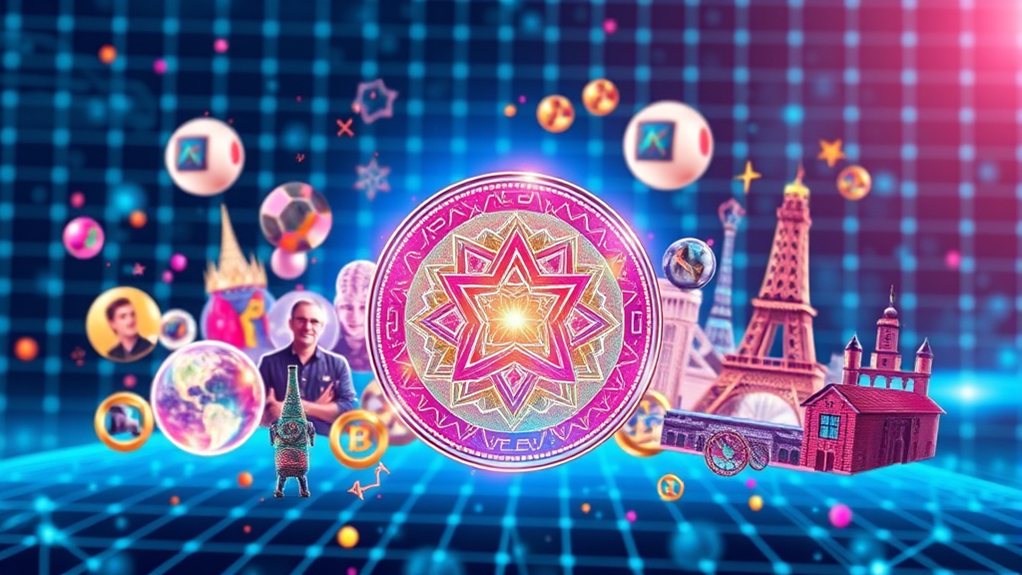Non-fungible tokens (NFTs) are unique digital assets stored on blockchain technology. Unlike cryptocurrencies, they can't be exchanged equally for one another. Each NFT contains special coding that verifies its uniqueness and ownership. They're commonly used for digital art, collectibles, gaming items, and virtual land. The global NFT market reached $26.9 billion in 2023 and continues to grow at 34.5% annually. The technology behind these digital certificates offers much more than meets the eye.

As digital technology continues to evolve, Non-Fungible Tokens (NFTs) have emerged as a revolutionary way to own and trade unique digital assets. Unlike cryptocurrencies such as Bitcoin or Ethereum, which are fungible and can be exchanged on a like-for-like basis, NFTs represent something truly unique. They're digital items stored on a blockchain that can't be replicated or divided into smaller parts.
NFTs serve as certificates of authenticity for digital or physical items. Each token contains special coding that verifies its uniqueness and ownership. This blockchain technology creates a transparent, secure record that can't be altered. The uniqueness of NFTs has created new markets for digital art, collectibles, virtual real estate, and more.
The technology behind NFTs relies primarily on blockchain platforms like Ethereum and Solana. Most NFTs follow specific token standards such as ERC-721 or ERC-1155. These standards define how the tokens function. When someone "mints" an NFT, they create a new token on the blockchain using smart contracts—self-executing agreements with terms written directly into code. The minting process ensures that each NFT maintains its authenticity and cannot be substituted with another token.
The global NFT market has grown substantially, reaching a value of $26.9 billion in 2023. Experts predict continued growth at a rate of 34.5% annually through 2030. Digital art remains the largest segment, but collectibles, gaming items, and virtual land are gaining popularity. In fact, blockchain gaming now accounts for 30% of NFT activity and attracted $1.1 billion in investments in Q2 2024. Many brands, celebrities, and sports leagues have embraced NFTs to connect with fans, particularly millennials and Gen Z consumers.
The applications for NFTs extend beyond art and collectibles. They're now used for event tickets, membership passes, identity verification, and intellectual property management. Some platforms allow for fractional ownership of high-value NFTs, making expensive assets accessible to more people. This flexibility has opened new possibilities for digital commerce.
NFTs offer several advantages in the digital economy. They create scarcity in an online world where copying is easy. For creators, NFTs enable direct sales to consumers without middlemen. Buyers receive verifiable proof of ownership and authenticity. These benefits have attracted artists, designers, musicians, and other creators to the NFT space. The smart contracts utilized in NFTs can automatically distribute royalties to creators whenever their work is resold on secondary markets.
Despite their potential, NFTs face significant challenges. Critics point to the environmental impact of blockchain networks that use energy-intensive processes. The market has seen instances of fraud and copyright infringement. NFT prices can be highly volatile, raising concerns about their speculative nature.
The lack of clear regulations also presents risks for buyers and sellers. Questions remain about the long-term value and utility of many NFTs as the technology and market continue to develop.
Frequently Asked Questions
How Do I Create and Sell My Own NFT?
Creating and selling an NFT involves several steps.
First, an artist selects a digital creation like artwork or music.
Then, they choose a marketplace such as OpenSea or Rarible and connect a cryptocurrency wallet.
Next, they upload their file, add description details, and pay gas fees to mint the NFT.
Finally, they list it for sale at a fixed price or auction and promote it online.
Are NFTS Environmentally Harmful Due to Energy Consumption?
NFTs have faced criticism for their environmental impact. Before Ethereum's 2022 update, minting an NFT used about 340 kWh of electricity—equivalent to three days of power for a European resident.
Each transaction produced roughly 211 kg of carbon dioxide. However, Ethereum's switch to Proof-of-Stake technology reduced energy consumption by 99.95%.
Alternative blockchains and carbon offset programs also offer less energy-intensive options for NFT creation and trading.
Can I Invest in NFT Marketplaces Rather Than Tokens?
Yes, investors can put money into NFT marketplaces instead of individual tokens.
Public companies like Coinbase and eBay offer exposure to the NFT market. Private companies such as OpenSea also exist, but aren't available on stock exchanges.
Some people choose ETFs that include NFT-related stocks. This approach provides diversification and potential revenue from transaction fees, though regulatory uncertainty and competition remain concerns.
What Happens to My NFT if the Platform Disappears?
NFTs remain on the blockchain even if a platform shuts down. The ownership record doesn't vanish. Users can still access their NFTs through alternative marketplaces or self-custody wallets.
However, if the platform stored the NFT's visual elements off-chain, these might become unavailable. The biggest risks include broken links to the actual media files and reduced trading options until the NFT appears on other platforms.
Are NFT Profits Subject to Capital Gains Tax?
Yes, NFT profits are subject to capital gains tax.
The IRS classifies NFTs as property, making sales taxable events. When someone sells an NFT for more than they paid, they'll owe taxes on that profit.
Short-term gains (held less than a year) face higher rates than long-term gains. NFT creators may also pay ordinary income tax on initial sales.
State taxes may apply as well.










